The Danleers
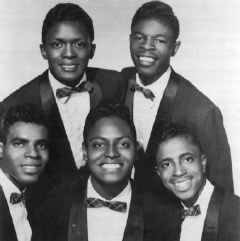
Top: l to r: Roosevelt Mays, Nat McCune
Bottom (l to r) Willie Ephraim, Jimmy Weston, Johnny Lee
The Danleers formed while teenagers in Brooklyn in 1958. The group's only big hit
"One Summer Night" came the summer of 1958. Written by the group's manager Danny
Welch it featured the lead voice of Jimmy Weston

Members -Mercury Records
Jimmy Weston - lead
Johnny Lee - first tenor
William Ephraim - second tenor
Nat NcCune - baritone
Roosevelt Mays - bass |
Members - Mercury Records
Jimmy Weston
Louis Williams - first tenor
Douglas Ebron - second tenor
Terry Williams - baritone
Frankie Clemons - bass replaced by Bill Carey |
|
|
Artist Biography by Craig Harris
With their debut single "One Summer Night," the Danleers became
one of the most successful vocal groups of the late '50s. Written by the group's
songwriter/manager Danny Webb and recorded during their first recording session, the tune
reached the pop Top Ten and sold over a million copies. The Danleers were one of many
vocal groups that arose out of the street corners, playgrounds, and tenement hallways of
Brooklyn. Originally a quintet, featuring lead singer Jimmy Weston, baritone singer Nat
McCune, bass vocalist Roosevelt Mays, and tenors Johnny Lee and Will Ephraim, the band's
sound was reinforced by the addition of Webb.
Initially released on the Amp-3 label, "One Summer Night" quickly became a local
hit and attracted the attention of Mercury, who reissued the tune in June 1958.
After performing at Alan Freed's Labor Day Extravaganza at the Brooklyn Fox Theater, the
Danleers were invited to join Frankie Avalon, Bobby Darin, Eddie Cochran, Connie Francis,
Dion & the Belmonts, Buddy Holly & the Crickets, Clyde McPhatter, and the Coasters
in a nationally touring road show.
"One Summer Night" marked the last success for the Brooklyn-based group,
however. After three attempts to recapture the momentum of "One Summer Night"
failed, the group was dropped by Mercury. Reorganized, with different personnel, by
Weston, the Danleers released two singles in the mid-'60s that failed to revive their
early success.
The Dells
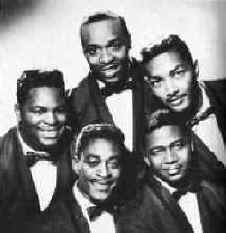
Clockwise from top: Chuck Barksdale, Mike McGill, Vance Allison, Johnny
Carter, Marvin Junior
One of the most durable acts in vocal group history, the Dells stayed together
for for thiry-five years with only one member change

Members:
Johnny Funches - lead - replaced by Johny Carter 1958
Marvin Junior - first tenor
Verne Allison - second tenor
Lucius McGill - baritone - replaced by Mickey McGill
Chuck Barksdale - bass replaced by Calvin Carter
After nearly four decades of recording an incredible legacy of hits, The
Dells have made only one personnel change in their entire professional career. Perhaps
that's why the venerable R&B vocal group can boast such a remarkably consistent track
record. The quintet from Chicago's south suburbs has weathered stylistic shifts from
doo-wop and soul to disco and urban contemporary, and every permutation in between. Their
harmony remains as striking as ever, with Marvin Junior's earthshaking lead enduring as
the group's focal point. Signing with Vee-Jay in 1955, their creamy vocal blend on  "Oh,What a Night" gave The Dells
their first major R&B hit the next year, but it would be nearly a decade before they
returned to the winner's circle with another dreamy classic, "Stay in My
Corner." By then Chicago's R&B sound had changed drastically -- doo-wop was dead
and soul was king -- but The Dells adapted effortlessly, regularly scaling the charts for
the Chess subsidiary Cadet with "There Is," "Always Together,"
"Give Your Baby a Standing Ovation," and a marathon remake of "Stay in My
Corner" that afforded Junior's booming baritone room to roam. Seemingly an
indestructible force (turning up on the R&B charts as recently as 1984), the succinct
harmonies of The Dells span entire generations of R&B history. ~ Bill Dahl, All-Music
Guide
"Oh,What a Night" gave The Dells
their first major R&B hit the next year, but it would be nearly a decade before they
returned to the winner's circle with another dreamy classic, "Stay in My
Corner." By then Chicago's R&B sound had changed drastically -- doo-wop was dead
and soul was king -- but The Dells adapted effortlessly, regularly scaling the charts for
the Chess subsidiary Cadet with "There Is," "Always Together,"
"Give Your Baby a Standing Ovation," and a marathon remake of "Stay in My
Corner" that afforded Junior's booming baritone room to roam. Seemingly an
indestructible force (turning up on the R&B charts as recently as 1984), the succinct
harmonies of The Dells span entire generations of R&B history. ~ Bill Dahl, All-Music
Guide
The Dells were inducted into the Rock and Roll Hall of Fame in 2004
The Del Satins
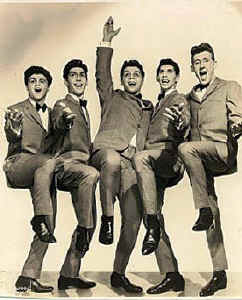
The Del Satins were one of the best white male doo wop groups.

Members:
Stan Sommers - lead - replaced by Carl Parker
Les Cauchi - first tenor
Richie Greene - second tenor
Freddie Ferrara - baritone
Tommy Ferrrara - bass
R&B artists the Del-Satins had few peers as practitioners of white
doo-wop in the 60s. They were formed in 1958 in Manhattan, New York, USA, by Stan Ziska
(lead), Fred Ferrara (baritone), his brother Tom Ferrara (bass), Leslie Cauchi (first
tenor) and Bobby Fiela (second tenor). The Del-Satins was chosen as their name in open
tribute to their principal influences, the Dells and Five Satins. Under the new name they
secured a recording contract with End Records.Their debut single, ‘I’ll
Pray For You’, was released in 1961. New management was sought with Passions manager
Jim Gribble, who found them a more permanent contract at Laurie Records. Their label star
Dion was at the time grappling with diminishing chart returns after an impressive start,
and wanted to replace his existing backing band, the Belmonts, with a ‘rockier’
troupe. The Del-Satins were instantly sent to work on Dion’s new song,
‘Runaround Sue’, a two-week number 1 in the Billboard charts. Although their
contribution to the hit was substantial, the Del-Satins received none of the credit. They
stepped out on their own for ‘Counting Teardrops’ for Winn Records, before
reuniting with Dion for ‘The Wanderer’, which stalled just one place short of
the number 1 spot in the US charts. The follow-up, ‘Lovers Who Wander’, peaked
at number 3, emphasizing the power of the Dion/Del-Satins coalition. While the combination
was charting once more with the kazoo-led ‘Little Dianne’, the Del-Satins
released ‘Teardrops Follow Me’, their first own-name outing to garner serious
sales, after which they found regular work on television (Alan Freed) and radio (Freed and
Murray The K). Back with Dion for the number 5 ‘Love Came To Me’, the
Del-Satins’ own ‘Does 'My Love Stand A Chance’ did not fare well. In 1962
they moved to Columbia Records as part of Dion’s new contract, which began with a
version of the Drifters’ ‘Ruby Baby’, another substantial hit at number 2.
Still frustrated by their lack of recognition, in 1963 the Del-Satins auditioned for Phil
Spector but declined his subsequent invitation to record with him. Meanwhile, in
appreciation for their past efforts on his behalf, Dion wrote a song for the Del-Satins
for single release, ‘Feeling No Pain’, but without his name to accompany it
there was no chart return. Two more hits with their mentor followed, ‘Donna The Prima
Donna’ and ‘Drip Drop’, before new manager Jay Fontana found the group a
home at Mala Records. This relationship lasted for only one single, ‘Two Broken
Hearts’, before three more efforts at B.T. Puppy Records. These included a rendering
of the Drifters’ ‘Sweets For My Sweet’, but afterwards Ziska left (for the
Magnificent Men) and was temporarily replaced by Carl Parker. In 1966 the Vietnam War
robbed the group of Cauchi and Tommy Ferrara, but the Del-Satins continued to play live
with the addition of Richard Green, Mike Gregorio and Johnny Maestro (ex-Crests). When
Cauchi returned he and the Del-Satins became Brooklyn Bridge. In 1991 the original
Del-Satins re-formed for nostalgia shows.
The Dubs
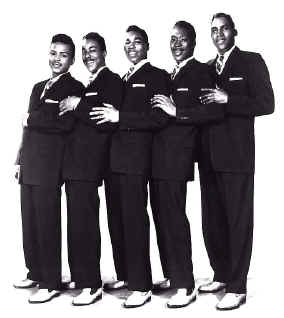
Left to right: William Carlise, Richard Blanton, Tommy Grate Cleveland Still, James Miller
The Dubs were the outgrowth of two fine but short lived mid-50s rhythm and
blues groups, the 5 Wings and the Scale-Tones.

Members:
Richard Blandon - lead
Cleveland Still - first tenor
Cordell Brown - second tenor - replaced by William Carlisle
Tommy Grate - bass
James Miller - baritone
The Dubs made one of the mid-'50s' more endearing ballad records,
"Could This Be Magic," in 1957. It wasn't a huge hit, but still became a doo wop
classic. The group, featuring lead vocalist Richard Blandon, continued recording for Gone,
Musictone, ABC, End, Josie, Wilshire, Lana, Candlelite, Johnson, and Clifton through the
mid-'70s, but never enjoyed any success or made any headway outside doo wop circles. ~ Ron
Wynn, All-Music Guide
The Duprees
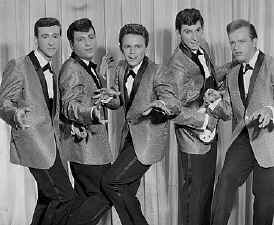
From the left: John Salvato, Mike Arrnone, Joe Canzano, Joe Santollo, Tom
Bialaglow, 1962
The Duprees made every ballad sound like an old standard

Members:
Joe Vann - lead - replaced by Mike Kelly
Joe Santollo - first tenor
John Salvato - second tenor
Mike Arnone - baritone
Tom Bialaglow - bass
One of the final Italian doo wop groups to make a wave in the early '60s,
the Duprees were in some senses not a rock & roll act at all. They relied on updates
of pre-rock pop standards for most of their material, dressed up in classy big-band
arrangements. Their New Jersey street-corner roots were still audible in their doo wop
harmonies, giving their treatments of moldy oldies enough of a contemporary flavor to
compete in the rock and pop marketplace. They were very good at what they did, and in
1962-63, they were very successful: "You Belong to Me" (previously recorded by
Jo Stafford, Patti Page, Dean Martin, and Joni James) made the Top Ten, and "My Own
True Love" (from the soundtrack of Gone with the Wind), "Have You Heard,"
and "Why Don't You Believe Me" were also Top 40 hits. The Duprees were already
retro when they were at their peak, and were washed out by the British Invasion, although
they continued to record throughout the late '60s, sometimes in a Jay & the
Americans/Vogues style. ~ Richie Unterberger, All-Music Guide
The Earls
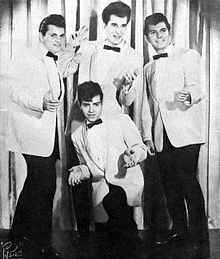
Back L to R: Robert Del Din, John Wray, Eddie Harder
Bottom: Larry Chance
A truly innovative group, the Earls interepted rhythm and blues ballads in their
own rock and roll style

Members:
Larry Chance (real name Larry Figueiredo) - lead
Robert Del Din - first tenor replaced by Ronnie Calabrese
Eddie Harder - second tenor
Lary Palumbo - baritone
John Wray - bass - replaced by Bob Moricco
Among the more revered white doo wop groups, the Earls began as the High Hatters. They
formed in 1957 at the Tecumseh Social Club in the Bronx. Lead vocalist Larry Figueiredo
changed his name to Larry Chance; he was joined by Bob Del Din, Eddie Harder, Larry
Palumbo, and Jack Wray. They started recording for Rome in 1961. They scored their lone
hit in 1963 with "Remember Then" for Old Town. It barely cracked the R&B Top
30 (number 29), but they continued until 1970, when they disbanded. The Earls gave it
another try in 1975 with Chance on board again, this time singing with Ronnie Calabreese
and Tony Olbert.
Nino and the Ebb Tides
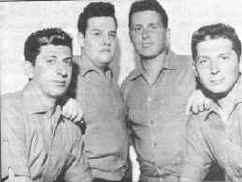
One of the first purveyors of rock nostalgia, Nino and the Ebb Tides started as the
Ebbtides from the Bronx, in 1956

Members:
Antonio Aiello - lead
Tony Delesio - baritone -replaced by Ralph Bracco (tenor) -
replaced by Tony BiBari 1960
Vinnie Drago - bass
Rudy ? - replaced by Tony Imbimbo (baritone)
Formed in the Bronx, New York, USA, the Ebb Tides (as they were originally
called) featured classmates Antonio ‘Nino’ Aiello (lead), Tony Delesio
(baritone), Vinnie Drago (bass) and Rudy (tenor). Their recording debut, ‘Franny
Franny’, came after meeting talent scout Murray Jacobs in 1957. By the end of the
year they had extended their title to Nino And The Ebb Tides and transferred to Recorte
Records. Their second single, ‘Puppy Love’, saw Delesio and Rudy replaced by
Tony Imbimbo (baritone) and Ralph Bracco (tenor). This sold well in the New York area,
but, like its successors, ‘I’m Confessin’’ and ‘Don’t Look
Around’, it failed to make any national headway. In 1960 Tony DiBari replaced Bracco
and the group moved to Marco Records. This resulted in only one single,
‘Someday’, before they joined Madison Records. Their first effort for Madison
was a version of ‘Those Oldies But Goodies (Remind Me Of You)’, but its impact
was dulled by a competing version by Little Caesar And The Romans. The Ebb Tides followed
up with another nostalgic doo-wop record, ‘Juke Box Saturday Night’. This at
last brought them mainstream success. Like its predecessor, it used snatches of familiar
doo-wop classics in the background, and peaked at number 57 in the US charts. Despite the
breakthrough, Madison was suffering financial difficulties and the Ebb Tides moved on
again, this time to Mr Peacock Records. However, ‘Happy Guy’ failed to chart,
though more damaging was the group’s decision to pass on a song written by Ernie
Maresca, ‘The Wanderer’, which became a massive seller for Del-Satins. The Ebb
Tides folded in 1965 after a handful of singles for ever more obscure labels. They did
reunite in 1971, however, and again in the 80s for a series of 50s revival show
The Edsels
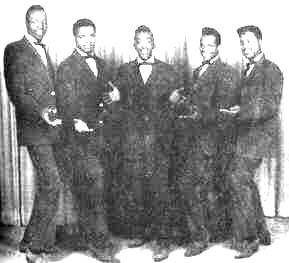
L to R: Marshall Sewell. Larry Green, George Jones Jr., Harry Green, James
Reynolds
If you don't succeed now, pray someone plays your record later, is a bit of advice that
would have beenpresscient for the Edsels.

Members:
George Jones Jr. - lead
Larry Green - first tenor
Harry Green - baritone
James Reynolds - second tenor
Marshall Sewell - bass
A brief encounter with fame came for the Edsels when they recorded the doo
wop masterpiece "Rama Lama Ding Dong." Originally released in 1959, the single
became a hit some three years after its initial release, thanks to the efforts of diligent
record collectors and disc jockeys.
Taking their name from Ford's legendary failed automobile, the Edsels formed in the tiny
mill town of Campbell, OH, in the late '50s. The group consisted of lead vocalist George
Jones, Jr., James Reynolds, Marshall Sewell, Harry Greene, and Larry Greene. The group
auditioned for a local Ohio music publisher in 1958. Through the publisher, the group
landed a record deal with the small Dub Records. The Edsels' first single was a song Jones
had written, "Rama Lama Ding Dong." The first pressings on Dub Records were
mislabeled "Lama Rama Ding Dong."
"Rama Lama Ding Dong" became a local hit, but made no impact nationally. In
1961, disc jockeys began playing the song again because it sounded similar to the Marcels'
current hit, "Blue Moon." Within a few months, the single was re-released on
Twin Records -- this time with the correct song title -- and it quickly scaled the pop
charts, peaking at number 21. Ironically, the group had broken up by the time "Rama
Lama Ding Dong" became a hit in 1961.
The Elegants
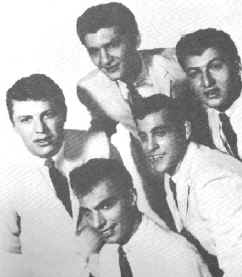
(clockwise from top) Frank Fardogno, Carmen Romano, Jimmy Moschella, Vito
Picone, Artiie Venosa
A Mozart melody became an inspiration for these five singing teenagers in Staten Island,
New York

Members:
Vito Picone - lead
Artie Venosa - first tenor
Frank Fardogno - second tenor
Carmen Romano - baritone
Jimmy Moschella - bass
This New York doo wop group earned notoriety for their masterpiece
"Little Star" in 1958, which topped both R&B and pop charts. They were a
White ensemble led by Vito Picone, With Arthur Venosa, Frank Tardogno, Carmen Romano, And
James Mochella. All had been in other groups before uniting as The Elgins. They continued
recording for Hull, United Artists, Limelight, Photo, IPG, and Laurie through the '50s,
'60s and into the '70s, but never had another hit, despite cutting a number of solid
ballads. There were two other editions in the mid-'60s, Vito Piccone with the Elegants and
Vito & The Elegants. ~ Ron Wynn, All-Music Guide
The Eternals
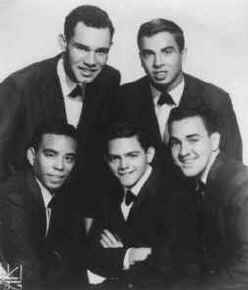
Top Row (L-R) Fred Hodge and Ernie Sierra
Bottom Row (L-R) Alex Miranda, Anibal Torres, Charlie Girona
The Eternals were a novelty-record vocal act with a Latin styling

Members:
Charlie Girona - lead
Fred Hodge - first tenor
Ernie Sierra - second tenor
Arnie Torres - baritone
Alex Miranda - bass
Artist Biography by Bryan Thomas
These Eternals were a vocal group who scored big with "Rockin' in the Jungle";
the "other" Eternals were based in Winnipeg, Manitoba, and recorded several
cover songs that became Canadian hits in the late '60s.
The Eternals formed during the late '50s, in the Freeman Street neighborhood of the Bronx,
where the quintet -- Charlie Gerona on lead, Fred Hodge on first tenor, Ernie Sierra on
second tenor, Arnie Torres on baritone, and Alex Miranda on bass -- started out singing in
junior high school as the Gleamers, cutting their teeth on covers by the Flamingoes and
the Spaniels; Gerona, meanwhile, was crafting songs in the humorous pop tradition of the
Coasters, the Cadets, and the Olympics. Soon the Gleamers were calling themselves the
Orbits, and developing a sound all their own. A novelty Gerona penned for the holidays,
"Christmas in the Jungle," which came complete with jungle sounds and bird calls
(mostly done by Torres) received airplay from the Murray the K and WABC's disc jockey
Bruce Morrow's shows and soon became their calling card.
Their new manager, Bill Martin, a friend of Morrow's, then turned them on to Melba Records
chief Morty Craft, who put the group in Beltone Studios in late spring of 1959 to record
the song, which by now had been changed to "Rockin' in the Jungle." The
group also felt that a new name was in order and crowned themselves the Eternals, no doubt
hoping for everlasting success. "Rockin' in the Jungle" was released in early
summer on Craft's new Hollywood Records label, becoming an immediate hit in New York
(number 11 locally). On July 13th, the song hit Billboard's national Pop Charts, where it
lodged at number 78. The Eternals' second novelty release -- "Babalu's Wedding
Day" -- was just starting to break, when the Etemals' manager felt compelled to sue
shady booking agents who were apparently attempting a less-than-ethical move on the group.
As a result of the court case, "Babalu's" distribution was stopped and the
Eternals were denied their shot at stardom. (The single became a jingle on WABC disc
jockey Bob Lewis' radio show and helped kept the group's image alive for years to come).
In January 1961, the Eternals' last single was issued through Morty Craft's Warwick
Records. The A-side was written by new member George Villanueva, who also sang lead, and
should have been a hit but more legal entanglements kept the record from charting. The
group disbanded in 1962, but by 1972 they re-emerged for a show at the Academy of Music
(the lineup now featured Ernie Sierra, George Villanueva, Arnie Torres, Richard Sierra,
and Hector Garcia). Another lineup -- Sierra, Villanueva, Herman Velez, Tito Santiago, and
Freddie Clavel -- are still going strong today on the oldies circuit.










